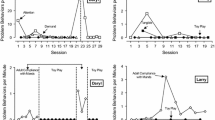Abstract
Noncompliance to requests is a behavior commonly exhibited by persons with developmental disabilities. Typically, differential reinforcement procedures, combined with response contingent consequences, are employed to manage noncompliance. An option to traditional operant methodologies is a stimulus control approach whereby various antecedent events are manipulated in an effort to set the occasion for compliant behavior. This study demonstrates how the noncompliant behavior (i.e., dropping to the ground and refusing to walk after exiting a van) of a multiply handicapped young adult was eliminated as a result of a compliance shaping intervention. A stimulus control analysis suggested that all elements of the intervention were critical to the success of the program. Follow-up assessment conducted 6 months after completion of training revealed maintenance of treatment effects.
Similar content being viewed by others
References
Horner, R. H., Day, H. M., Sprague, J. R., O'Brien, M., and Heathfield, L. T. (1991). Interspersed requests: A nonaversive procedure for reducing aggression and self-injury during instruction.J. Appl. Behav. Anal. 24: 265–278.
Luiselli, J. K. (1990). Recent developments in nonaversive treatment: A review of rationale, methods, and recommendations. In Repp, A. C., and Singh, N. N. (eds.),Perspectives on the Use of Nonaversive and Aversive Interventions for Persons with Development Disabilities, Sycamore Publishing, Sycamore, IL, pp. 76–86.
Mace, F. C., Hock, M. L., Lalli, J. S., West, B. J., Belfiore, P., Pinter, E., and Brown, D. (1988). Behavioral momentum in the treatment of noncompliance.J. Appl. Behav. Anal. 21: 123–141.
Parrish, J. M., Cataldo, M. F., Kolko, D. J., Neef, N. N., and Egel, A. L. (1986). Experimental analysis of response covariation among compliant and inappropriate behaviors.J. Appl. Behav. Anal. 19: 241–254.
Repp, A. C., and Singh, N. N. (1990). (Eds.).Perspectives on the Use of Nonaversive and Aversive Interventions for Persons with Developmental Disabilities, Sycamore Publishing, Sycamore, IL.
Russo, D. C., Cataldo, M. F., and Cushing, P. J. (1981). Compliance training and behavioral covariation in the treatment of multiple behavior problems.J. Appl. Behav. Anal. 14: 209–222.
Singer, G. H. S., Singer, J., and Horner, R. H. (1987). Use of pretask requests to increase the probability of compliance for students with severe disabilities.J. Assoc. Pers. Sev. Hand. 12: 287–291.
Slifer, K. J., Ivancic, M. T., Parrish, J. M., and Burgio, L. D. (1986). Assessment and treatment of multiple behavior problems exhibited by a profoundly retarded adolescent.J. Behav. Ther. Exp. Psychiatry 17: 203–213.
Sulzer-Azaroff, B., and Mayer, G. R. (1991).Behavior Analysis for Lasting Change, Holt, Rinehart and Winston, Inc., Orlando, FL.
Author information
Authors and Affiliations
Additional information
Psychological and Educational Resource Associates.
Rights and permissions
About this article
Cite this article
Cameron, M.J., Luiselli, J.K., McGrath, M. et al. Stimulus control analysis and treatment of noncompliant behavior. J Dev Phys Disabil 4, 141–150 (1992). https://doi.org/10.1007/BF01046396
Issue Date:
DOI: https://doi.org/10.1007/BF01046396




